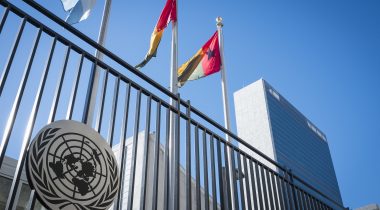
Naomi Fowler ■ Illicit financial flows and the tax haven and offshore secrecy system

We’re sharing below the work of one of our senior advisers, Sol Picciotto, Emeritus Professor of Law at Lancaster University on defining illicit financial flows. You can also hear him interviewed on this subject in our podcast:
Illicit financial flows and the tax haven and offshore secrecy system
The importance of reducing, and eventually eliminating, illicit financial flows, has now been recognised in the Addis Ababa Action Agenda of the United Nations, as key to ensuring good governance, as well as contributing to the domestic resource mobilisation necessary for achieving the Sustainable Development Goals, adopted in 2015.[1] However, there is now some debate about what is covered by this term.
There are several components of illicit financial flows, but all of them make use of the same facilities provided by the tax haven and offshore secrecy system. They include:
- the concealment of the proceeds of crime or corruption;
- tax evasion;
- tax avoidance and tax planning;
- hiding wealth from public agencies, business associates, or family members.
Offshore is a murky world which facilitates a range of criminal, illegal, illegitimate and undesirable practices, all covered by the broad term illicit. This murkiness feeds from several elements:
- opacity due to secrecy rules and weak arrangements for international sharing of information;
- complexity of the structures involving chains of entities in different jurisdictions;
- difficulties and divergences in interpreting abstract legal concepts;
- the imbalance of resources between avoiders and enforcers of the rules;
- weak political support for vigorous enforcement against the wealthy and powerful.
The activities taking advantage of these features certainly cover a very wide spectrum. They range from facilitating serious crime to behaviour which is unethical or undesirable, such as concealing assets from family members or business associates. It is sometimes said that many of these activities are ‘perfectly legal’, and hence legitimate.
However, if they are legal, there is no need to carry them out offshore. Offshore devices or structures all involve using the laws or facilities of another country to obtain an advantage not possible under the law that should apply. Private persons’ bank accounts, financial information and other aspects of their personal affairs are generally protected in all countries by laws on confidentiality and privacy, which can only be overridden in specified circumstances, when there is a public interest. There is a network of tax treaties aimed at preventing double taxation, and in any case countries wishing to attract investments generally provide inducements, not excess taxation. Resorting to an offshore arrangement always involves trying to get around an inconvenient law – dodging the law.
Illegality and crime can hide behind the same veil as behaviour claiming to be legal, although unethical. Activity claiming to be legal also provides cover for illegality. In practice it can be hard to draw lines between them.
Evasion, avoidance and illicit practices
It is important to clarify that there are three broad types of illicit activities. One may involve breach of criminal laws, such as money-laundering, and is usually termed evasion. A second entails using often complex legal structures to try to avoid the law. If such arrangements are discovered they may be challenged and found to be unlawful. Both of these can be termed illegal. Thirdly, some activities which are against the public interest manage to escape the legal net. Often laws are changed to prevent their future use. All of these come within the broad term illicit. Although these categories can be defined in principle, the lines between them are often blurred.
Take the distinction between tax evasion, which is criminal (also termed tax fraud), and avoidance, which is often described as legal. There is a grey area between them, mainly because it is often hard to prove the deliberate intent needed for a criminal conviction. This is made more difficult because the wealthy can pay lawyers to devise complex structures which exploit ambiguities and loopholes in the law, and to provide plausible arguments that the arrangements should be considered legal. This ‘tax planning’ aims to defeat the aim or purpose of a law by devising schemes to achieve the same economic result, but by different means which arguably comply with the letter of the law. This can lead to a cat-and-mouse game, in which as fast as tax authorities close up a loophole, the fertile minds of tax avoiders create a new one.
It is very hard to challenge such arrangements, especially because of the veil of secrecy and complexity which tax advisers create around them. Until very recently tax authorities could not obtain information from abroad, especially from such secrecy jurisdictions – indeed many countries were reluctant to help other countries enforce their taxes.[2]
To improve transparency, some countries have introduced requirements to notify avoidance arrangements to the tax authorities. The first scheme specifically aimed at requiring reporting of cross-border tax avoidance arrangements, and for these reports to be shared between tax authorities, was put forward by the European Commission in June 2017.[3] However, a notification requirement alone is little deterrent, as the tax can remain unpaid for years while its legal validity is tested. Even if a scheme is found unlawful, the work of having devised it is not necessarily illegal. To combat this, the UK in 2014 introduced a procedure to require up-front payment of the tax due for schemes found after an initial review to be unlikely to succeed, and in 2017 a procedure to penalise enablers of failed ‘abusive’ schemes.[4]
Even if information can be obtained, tax authorities need substantial resources to disentangle and understand the complex structures involved, and mount a legal challenge. They are always outgunned by the army of well-paid enablers hired by the rich to protect their wealth, and some of the most able tax officials move to well-paid jobs as advisers.
Hence, there is an unknown but undoubtedly large amount of tax which could have been found payable if the authorities had sufficient resources. Some of this may be due to behaviour which might be found to be criminal, the rest to the use of devices which would be found invalid or unlawful, if the authorities had sufficient resources to obtain the necessary information and to challenge them. In general terms, all this activity is unlawful, and can rightly be termed illegal, even if it would be hard to prove criminality. It all clearly falls within the concept of illicit flows.
The grey areas of international tax
These categories are particularly contested in international tax, since its rules have become quite ineffective, often based on broad criteria requiring subjective interpretation. Thus, the lines are very blurred, not only between criminal evasion and avoidance, but also between unlawful and valid avoidance schemes. Since the term ‘illicit’ is quite wide, it is important to be clear about the various components, especially when making estimates of the amounts.
In particular, there can be confusion due to the use of the term ‘transfer mispricing’ in international trade. This can occur for example if there is collusion between an importer and an exporter, who may agree to issue an invoice for a lower price than actually agreed. The difference can be paid into an offshore account, to reduce import duties or evade exchange controls, resulting in an illicit financial flow from the country of import. Such practices are illegal evasion, indeed usually criminal.
This is different from the problem of transfer pricing within a TNC corporate group. When transactions take place between companies under common control, there is no ‘real’ price agreed between independent parties. International tax rules allow tax authorities to adjust the income of the associated entities, to reflect what they would have been if the transactions had been between unrelated parties. This is referred to as the ‘arm’s length principle’, but it is a legal fiction. The methods used to apply it require subjective judgement, which gives TNCs considerable scope to shift profits to countries where they will be more lightly taxed. This involves avoidance, which is difficult to counteract, especially for tax authorities in developing countries, since it requires tax officials with considerable expertise and determination.[5]
Such abusive transfer pricing uses some of the same techniques and facilities as transfer mispricing, but they are different in nature. Defeating them also needs a willingness to stand up to the aggressive tax avoidance practices of some companies, which depends on the political climate. For example, in 2012 it was reported that Starbucks, since it opened in the UK in 1998, had consistently declared tax losses – despite opening 735 outlets and generating over £3 billion in coffee sales with an operating profit margin of as much as 15%, it only paid income tax in one year, of £8.6 million. The losses declared were apparently due mainly to a royalty for the brand name and other intellectual property rights of 6%, which is at the ‘top end’ of the range considered permissible under transfer pricing rules (Bergin 2012). This income untaxed in the UK was paid to an affiliate in the Netherlands, acting as a conduit and transferring the bulk of the income offshore, so that little tax was payable in the Netherlands either. Following the publicity, the company voluntarily waived some deductions so that it paid £20m in UK tax, and later restructured its business to regularise a more publicly defensible level of UK tax (Houlder 2015). Although its transfer pricing arrangements were apparently not challenged in the UK, the European Commission in 2015 found that the low tax rate of its Netherlands affiliate was a breach of EU state aid rules, requiring a repayment of €20m-€30m, which is under appeal. The UK also in 2015 introduced a Diverted Profits Tax, aimed at pressurising TNCs not to use aggressive avoidance schemes such as this one.[6]
Hence, in addition to criminal evasion and unlawful avoidance, a substantial amount of international avoidance cannot adequately be tackled under current tax rules, which have become highly dysfunctional. The line between lawful and unlawful tax avoidance is both unclear and elastic, depending on both the resources available to tax authorities, and their willingness to use them. Nevertheless, all of this uses similar techniques, involving opacity, complexity, and chains of corporate vehicles and other entities formed in convenient jurisdictions. This was seen most recently in November 2017, with the leak of documents known as the Paradise Papers.[7] These are mostly from Appleby, a firm specialising in creating these vehicles, whose clients include both wealthy individuals and leading TNCs, such as Apple, Nike, Whirlpool and Glencore (Pouchard 2017). All these structures can rightly be regarded as coming within the term illicit.
Contested Concepts
Another factor contributing to the complexity is that avoidance exploits the indeterminacy of legal terms. Particularly key for international tax are the concepts of residence (especially for legal entities such as corporations) and of the source of income (Picciotto 2007). In addition to problems of interpreting such concepts, loopholes are also created by divergences between the laws of different countries in defining them. For example, under UK law (due to a decision by its highest court in 1906) a company was treated as resident where it was managed and controlled, interpreted to mean where its directors’ meetings were held. This made it easy to avoid tax using a UK company by holding its formal directors’ meetings in a low-tax jurisdiction, until the UK changed this rule in 1988. However, the same principle continued to apply in Ireland, which helped many US companies (notably Google) to use Irish affiliates (treated as resident elsewhere) to keep enormous profits offshore (in the case of Google, in Bermuda: see Drucker 2012). Tax advisers not only take advantage of such loopholes, often they help to create them, by lobbying pliant governments, sometimes even submitting drafts of suitable legislation. This is perhaps easier in small states where personal and family links connect business and politics (Drucker 2013).
Moreover, some schemes which may not themselves be illegal can facilitate evasion. A key example is investment funds, such as hedge funds and private equity funds. The world’s largest location for such funds is the Cayman Islands, which have no income tax. The only activity relating to these entities which takes place in Cayman is routine back-office work, employing a handful of people. The real decisions are made by highly-paid investment managers employed by companies in New York, London or elsewhere. Yet tax authorities in countries such as the UK and the US have accepted that the funds can be treated as resident in Cayman, and their income as sourced there (Sheppard and Sullivan 2008). Since Cayman has no income tax, the fund’s trading income and capital gains are untaxed, while the investment companies are taxed only on the fees they are paid for providing advice. More importantly, Cayman does not apply a withholding tax on distributions from such funds to investors. This income should be reported by the recipients for taxation in their country of residence, or they could be guilty of evasion. However, the payments are covered by strong secrecy laws, so clearly many fail to do so. But the fund organisers have committed no illegality, although they have organised the fund in a way which enables its investors to evade tax. The authorities in the major financial centres where fund management and investment take place have turned a blind eye, for fear of losing the investment management business to other centres.
Concerted counter-measures
These definitional issues are important, because they affect the design of the counter-measures. On the one hand, some in the rich and powerful countries prefer to point the finger at the small ones designated as tax havens or offshore centres, overlooking the corporate secrecy in Delaware or Nevada, and confidentiality for non-residents’ bank accounts in New York or Florida. Equally, since the international drive against money-laundering and terrorist financing, most of the offshore financial centres have clamped down on criminality, aiming to hold themselves out as clean and safe, while dragging their feet on measures to defeat tax avoidance. All are scrambling to preserve their reputations, to be able to attract as much as possible of the professional support work accompanying the management of large financial flows.
A narrow view of the nature of illicit flows would gravely weaken the counter-measures which are needed. As explained above, the offshore system is a murky world, in which activities claiming to be ‘perfectly legal’ can help conceal illegal and more plainly criminal behaviour. A systemic approach is needed for counter-measures. This should aim not only to target specific issues, but to change the culture which justifies avoidance. This includes notions such as that whatever is not clearly illegal is legitimate, that it is acceptable to devise complex arrangements to undermine the law (especially of another country), and that privacy extends well beyond the personal sphere and can be used to cloak in secrecy the affairs of giant corporations and the mega-wealthy.
[1] Addis Ababa Action Agenda adopted by the UN General Assembly August 2015, UN document A/RES/69/313, especially paras. 18 and 23.
[2] It was generally only possible if there was a tax treaty between the two countries, and only on request, i.e. if the person was already under suspicion. Also, many countries would not obtain information requested by another state unless they also had a tax interest in the person concerned. (This was so for the UK until 2000). The OECD strengthened the information exchange provision of its model treaty in 2005, resulting from the work on tax havens discussed in section 4 below.
[3] COM(2017) 335 final, 21.06.2017.
[4] After strong lobbying against the initial proposals it was limited to ‘abusive’ schemes, strictly defined (Finance No. 2 Act 2017, Schedule 16).
[5] For an analysis of the problem and a proposal for a more effective approach for developing countries, see Durst 2016.
[6] This raised £280m in its first full year, but is now forecast to raise £1.35b by 2019 (UK 2017, p. 6).
[7] See https://www.icij.org/investigations/paradise-papers/ .
Related articles

Ireland (again) in crosshairs of UN rights body

New Tax Justice Network podcast website launched!

People power: the Tax Justice Network January 2024 podcast, the Taxcast

As a former schoolteacher, our students need us to fight for tax justice
Submission to the UN Special Rapporteur on extreme poverty and human rights’ call for input: “Eradicating poverty in a post-growth context: preparing for the next Development Goals”
17 January 2024
Submission to the Committee on Economic, Social Cultural Rights on the Fourth periodic report of the Republic of Ireland

The Corruption Diaries: our new weekly podcast

Tax Justice Network Arabic podcast #73: ملخص 2023

ESCOLA DE HERÓIS TRIBUTÁRIOS #56: the Tax Justice Network Portuguese podcast


